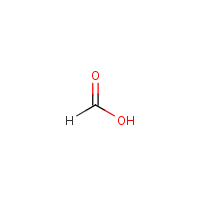Formic acid
Agent Name
Formic acid
CAS Number
64-18-6
Formula
C-H2-O2
Major Category
Other Classes

Synonyms
Acide formique [French]; Acido formico [Italian]; Add-F; Ameisensaeure [German]; Aminic acid; Bilorin; C1 acid; Collo-bueglatt; Collo-didax; Formic acid; Formic acid (natural); Formira; Formisoton; Formylic acid; Hydrogen carboxylic acid; Kwas metaniowy [Polish]; Kyselina mravenci [Czech]; Methanoic acid; Mierenzuur [Dutch]; Myrmicyl; Spirit of formic acid; [ChemIDplus] UN1779
Category
Organic Acids
Description
Colorless liquid with a pungent, penetrating odor. [Note: Often used in an aqueous solution.]; [NIOSH]
Sources/Uses
Used in electroplating, brewing, and mirror silvering; also used in the dyeing and finishing of textiles, paper, and leather; [ACGIH]
Comments
Liquid causes second degree burns after contact for a few minutes; [CHRIS] Highly corrosive to skin; [Quick CPC] Pulmonary edema can result from heavy inhalation exposure; [ICSC] TLV Basis is upper respiratory tract irritant;
Biomedical References
Exposure Assessment
Skin Designation (ACGIH)
Insufficient data
TLV (ACGIH)
5 ppm
PEL (OSHA)
5 ppm
MAK
5 ppm
IDLH (NIOSH)
30 ppm
Excerpts from Documentation for IDLHs
Basis for original (SCP) IDLH: Because no data on acute inhalation toxicity are available on which to base an IDLH for formic acid, the chosen IDLH is based on an analogy with formaldehyde, which has an IDLH of 30 ppm. . . . Human data: Workers exposed to about 15 ppm have complained of nausea [Fahy and Elkins 1954].
Vapor Pressure
42.6 mm Hg
Odor Threshold Low
1.6 ppm
Odor Threshold High
340 ppm
Lethal Concentration
LC50 (rat) = 15,000 mg/m3/15m
Explanatory Notes
Odor threshold from AIHA; Flash point = 156 deg F; VP from HSDB;
Reference Link #2
NFPA
high ambient temp required
ERPG-1
3 ppm
ERPG-2
25 ppm
ERPG-3
250 ppm
Adverse Effects
Toxic Pneumonitis
Yes
Dermatotoxin
Skin burns
Diseases, Processes, and Activities Linked to This Agent
Processes
Industrial Processes with risk of exposure:
Activities
Activities with risk of exposure: